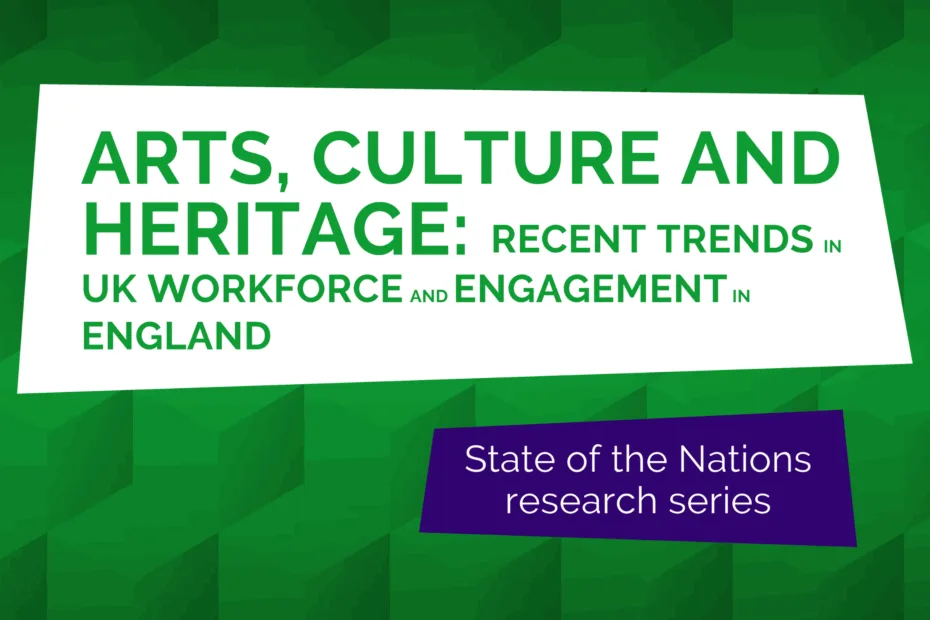A Creative PEC State of the Nations Report
With place based approaches to supporting culture are high on the political agenda, especially in England as new Strategic Authorities and local powers unfold, our latest State of the Nations report builds upon the previous research and provides fresh insight on arts and culture workforce and participation in England.
The research shows a widening gap by class and ethnicity in terms of who engages with arts and culture. It also shows significant regional discrepancies and for the first time the research also points to a relationship between places with high levels of people working in arts and culture and areas with higher participation. This adds weight to the idea that cultural plans should move beyond solely boosting engagement for local communities. In addition, they should also consider how opportunities within the local arts, culture and heritage workforce can be nurtured and sustained as a part of a more holistic approach.
In the workforce, people from more middle-class backgrounds continue to dominate the sector and fresh policies are needed to truly shift the dial. Perhaps the most significant findings are the variations in terms of engagement by locality within England. Key findings from the report are listed below.
Interactive Dashboard
To coincide with the report’s release, an interactive dashboard has been published. This tool supports those responsible for local growth and cultural planning to delve further into regional and local data.
Watch the video explainer on how to use the data dashboard
Key findings by place
- There are only 13 English local authorities where over 50% of the population has been to an art exhibition in the twelve months prior to the survey – all 13 are in London.
- The local authority with the highest percentage of residents visiting an art gallery in the 12 months prior to the survey is the City of London, at 70%; the local authority with the fewest is Boston, Lincolnshire at 11%.
- Other local authorities where the figure is high are Brighton and Hove (49%) and Oxford (46%); outside of the south of England, the highest figure is for York (37%).
Key findings by demographics
- The majority of areas showing this relationship are London boroughs with the next highest areas outside of London being Cambridge, Brighton and Hove, Oxford, Bristol and Waverley (in Surrey).
- There has been a widening gap in the last year between who engages with arts and culture by socio-economic background (comparing 2022/23 – with 2023/24). For example, there has been a 9% increase in the gap between middle class and working class people attending a live music performance, and a 7% increase in the gap for ‘attending an art exhibition’.
- There is large variation in engagement in cultural activities by socio-economic background e.g. 51% of people in managerial/professional households have been to the theatre in the last 12 months the figure for semi-routine/working class is 26%.
- The class differences are largest for museums and galleries, with 54% for managerial/professional and 31% for semi-routine/working class. In nearly all cases Black and Asian people are less likely than people in other ethnic groups to have engaged in the DCMS categorised arts, culture and heritage activities for example 23% of Black people and 19% of Asian people had attended live music, compared with 42% of White people.
- Local authorities with more people working in arts, culture and heritage also have greater rates of engagement in most forms of arts and culture. For example, six out of the ten local authorities with the largest percentage of people working in arts, culture and heritage occupations are also in the ten local authorities with the largest percentage of people having visited an art exhibition.
- The activities most strongly associated with people working in arts, culture and heritage and people ‘engaging’ are visuals arts (attending exhibitions) literary events and live dance.
Watch the launch event
If you missed the launch event for the report, watch an introduction to the research and interactive dashboard, plus opinion from expert panellists, Dr Helen Pheby, Head of Culture, Heritage and Sport with the West Yorkshire Combined Authority and Councillor Peter Golds CBE of Tower Hamlets Council.
What are State of the Nations reports?
Creative PEC’s ‘State of the Nations’ series analyses the latest data across four thematic areas to inform the development of policies relating to the creative industries. Their scope is the whole of the United Kingdom, and wherever possible data is presented for all the nations and regions. Regular reports on each area will be published biannually over the five yours of the Arts and Humanities Research Council (AHRC) funding. The themes and corresponding Research Consortium Partners are:
- R&D, Innovation and Clusters (University of Sussex)
- Internationalisation (Newcastle University)
- Arts, Culture and Heritage (University of Sheffield)
- Education, Skills and Talents (Work Advance)
The report is written by our consortium partner the University of Sheffield with additional support from the University of Manchester:
- Dr Mark Taylor, Senior Lecturer in Quantitative Methods, University of Sheffield
- Dr Ruoxi Wang, Research Associate, University of Sheffield
- Professor Dave O’Brien, Professor of Cultural and Creative Industries, University of Manchester
Citation: If the information in this report is used in any subsequent research and/or publications, please cite as follows: O’Brien, D., Taylor, M. and Wang, R. (2025) Arts, Culture and Heritage: recent trends in UK workforce and engagement in England. Zenodo. doi: 10.5281/zenodo.15303302.
The report was designed by Mike Green at Green Doe.
